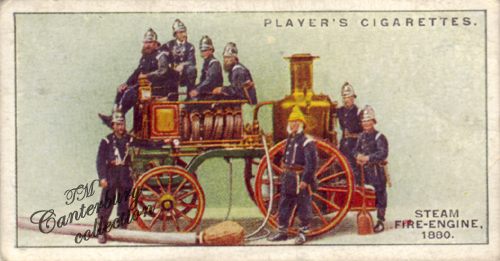
![]()
~ CANTERBURY FIREMEN ~
CANTERBURY
1692 - The purchase of a fire engine from the will of John Whitfieldman
Possibly members - William Gilbert Pidduck, Captain, Thomas William de Lasaux, 1st Lieut., Henry George de Lasaux, 2nd Lieut., Edward Beer, 3rd Lieut., Earl Mount Charles, 4th Lieut., Robert Pidduck, no. 5, Henry George Trimnell, no 6., William Banister, foreman and Edward Eves, engineer.
(The Insurance Gazette, March 1, 1869 - Mr. W. G. Pidduck, who being sworn, state that he was Captain of the Volunteer Fire Brigade and had charge of the County fire engine in this city.)
1872
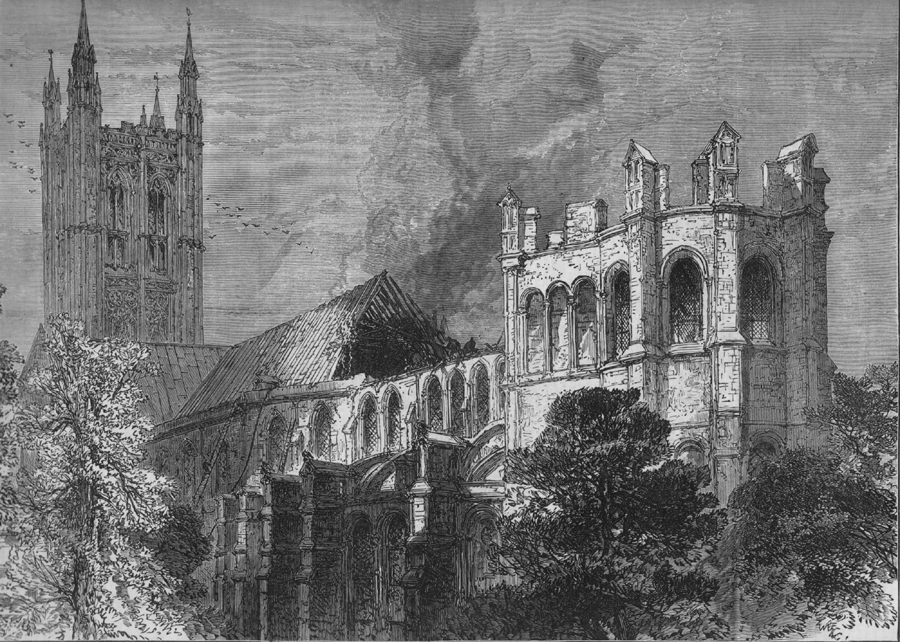
From the Illustrated London News September 14, 1872
THE FIRE IN CANTERBURY CATHEDRAL
The fire which destroyed the roof of the east end of Canterbury Cathedral, on Tuesday week, and which threatened the entire destruction of that venerable building, was mentioned in our last publication. It was caused by the upsetting of a pot of burning charcoal used by the plumbers employed to solder the leaden covering of the roof. The molten lead poured through to the woodwork below, and the roof in that part was soon on fire. It was then about half-past ten o'clock in the morning. The daily morning service had just concluded, but the choir had stayed behind to rehearse something for the afternoon. When he alarm was given he boys and lay clerks rushed from the building in their surplices, not knowing exactly the extent of the danger. The organ-blower in the meanwhile had the presence of mind to go to the tower and ring the great bell, thus making known to the city and neighbourhood something was amiss. Smoke and flames were soon seen issuing in volumes from that part of the east end of the roof near Beckett's crown, and by this time people were streaming into the precincts and viewing the conflagration in helpless dismay. It should be stated that two or three years ago very excellent waterworks were established in Canterbury, which are computed to supply the citizens with about 180,000 gallons per diem, from a reservoir on St. Thomas's-hill, and from which the service is continuous, at a pressure of 70lb to the square inch. Unfortunately, the Dean and Chapter, or their surveyor, had not yet got the hydrants of the water company fixed around the Cathedral; but the hose belonging to the Phoenix and Kent Fire Offices and to the City Volunteer Fire Brigade was of sufficient length to be affixed to the hydrants in the adjoining streets, and thence carried through the Cathedral yard to the burning building, the city brigade alone using 700 ft. for this purpose. Although the men belonging to the various brigades were on the spot as quickly as possible, it was not until twelve o'clock that any water could be got to touch the flames at all. Meanwhile the fire was gradually destroying the whole of the eastern roof. Indeed, up to this time so serious did matters look that the Vice-Dean, the Rev. Canon Thomas, telegraphed to Captain Shaw, of the steam fire-engines an order which, happily soon after had to be countermanded, as the flames were subdued. A telegram was also dispatched to Ashford for a further supply of hose, which was at once sent, with the Ashford Fire Brigade. About half-past eleven forty men belonging to the Cavalry Depot Brigade, under the command of Quartermaster Woods, and forty of the Royal Horse Artillery, marched into the precincts and rendered excellent service, both in assisting the local police to control the crowd and on the roof of the building.
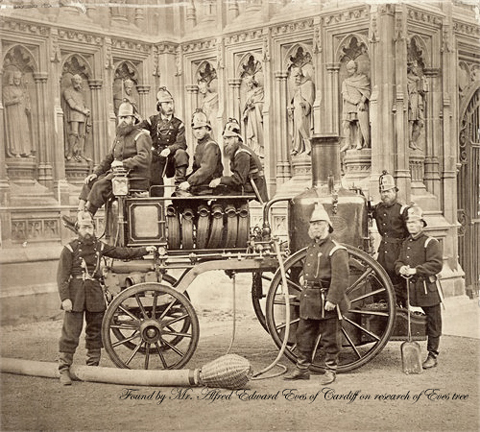
VOLUNTEER FIRE BRIGADE 1872 who helped
put out the fire in the Cathedral 14th September 1872.
The Fire engine & crew, Chief Engineer Edward Eves (The gentleman
on the far right holding the shovel)
The picture above found by Mr. Alfred
Edward Eves of Cardiff on research of the Eves Family Tree
The hose from the Phoenix Office was the first to reach the fire, and immediately afterwards Mr. George Delassaux*, of the Canterbury Volunteer Fire Brigade, at considerable personal risk, broke his way though one of the small windows in the clerestory, and, dragging his hose after him, brought a second stream to play upon the flames. Meanwhile the burning timers, with the vane which stood at the east end, had fallen in upon the groined roof below, and sparks and molten lead were dropping through the Trinity Chapel and Beckett's shrine, at the rear of the altar. An army of volunteers was quickly pressed into service, and everything inflammable was removed from the choir, even the heavy communion-table being taken away, the altar rails torn up, and the armour and shield of the Black Prince removed from the tomb where they have hung for centuries. By one o'clock it became apparent that the force of water from the hydrants was getting the upper hand of the fire, just as it was in contemplation to cut a vast gap in the roof, and so arrest the flames. The soldiers were working well both with the hose and the axe, cutting away the burning timbers, and a two o'clock a ringing cheer went up from the men on the roof, which was heartily joined in by the crowd below, in token of the extinguishing of the fire.
The building is insured in the Sun Fire Office for £20,000, and the damage is variously estimated at from £3000 to £5000. At the spot where the fire took place is some of the most valuable stained glass to be found in the cathedral, but very fortunately none of this is injured. The beautiful mosaic pavement in front of Beckett's shrine, or St. Thomas's Chapel, has also escaped damage. But that portion of the roof which covered Trinity Chapel, at the extreme east of the edifice, extending to the canopy over the spot which indicates where once stood the shrine of St. Thomas a Beckett, and over the altar and choir, is entirely gone.
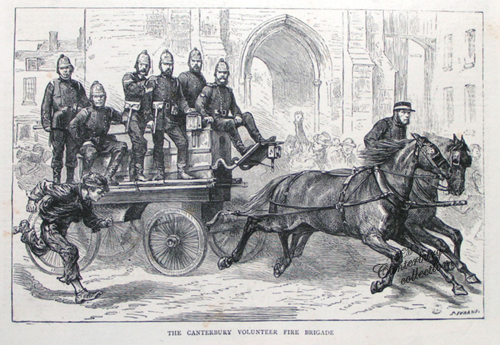
Volunteer Fire Brigade c. 1872, seen racing past the West Gate likely on their way to the Cathedral to help fight the fire (from my collection)
During the afternoon volunteer and other fire brigades entered the city from various neighbouring towns, but of course their services were not required. Archdeacon Harrison, Canon Thomas, and others of the cathedral body determined, shortly after the fire had been extinguished, not to abandon the afternoon service, which has been held daily without interruption during the past 300 years. To this end the immediate approaches to the building were thrown open and guarded by military and police in order that the dense volume of smoke might be allowed to escape. The hour of Divine service was altered from three to four o'clock, and at that hour, by dint of considerable exertions, the choir was made available for the accommodation of a large congregation. Archdeacon Harrision, who read the prayers, prefaced them by invoking the assembly to offer up thanks to God for his mercy in having saved the beautiful building from destruction. Subsequently a special Te Deum was solemnised, and the service throughout was of the most impressive nature.
By far the larger part of the present cathedral is the work of the Norman era, having been erected in the first half century after the Conquest, when Archbishop Lanfranc found the old cathedral in ruins, and "reconstructed from their foundation both church and monastery." Under his successor, Anselm, the eastern part of this edifice (which seems to have been only temporary in its design) was taken down and re-erected with great magnificence under the care of Ernulph, then prior of the monastery. It was finished by the next prior, Conrad, who decorated the chancel and eastern part with so much splendour that it came to be called "Conrad's glorious choir." The church was solemnly dedicated by Archbishop William, in A.D. 1130, in the presence of Henry I. of England, David King of Scotland, and all the English Bishops. It was in this building, as our readers are aware, that Beckett was murdered in A.D. 1170, and in the "choir of Conrad" his body was watched by the monks during the succeeding night. Four years later, on Sept. 5, 1174, this choir was burnt down; and we have a description of the conflagration from the pen of Gervaise, a monk of Canterbury, who was an eye witness of the event. The choir and eastern parts of the cathedral were rebuilt in 1184, the church having been closed several years. On the present occasion, we have reason to be thankful that the damage has been comparatively slight. Had the fire continued, not only "Beckett's Crown" and Henry IV.'s Chantry, and the Trinity Chapel, in which are the monuments of the Black Prince, Henry IV., Archbishop Courtenay, Cardinal Chatillon, and Dean Wotton would have perished, but the site of Beckett's shrine must have been entirely obliterated, together with the fine frescoes in the adjoining transept; an the tomb of Cardinal Pole, the last Archbishop interred in the cathedral, would have undergone the same fate.
Photographs of the effects of this fire were taken on the same day by Messrs. Barnes and Son, of Mile-end-road.
**In the 1870's George H. Delasaux age 24 was living at home with his father Thomas P. DeLasaux widower, who is a Wine & Spirit Merchant. They were living at 30 High Street in All Saints, Canterbury. George is noted as unemployed.
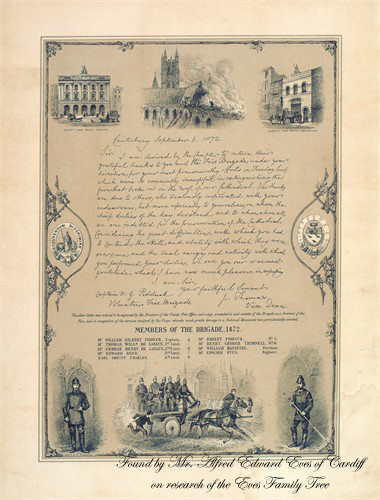
A letter sent by the Dean thanking the men for putting the fire out and naming the members
The letter above found by Mr. Alfred Edward Eves of Cardiff on research of the Eves family tree
1872 - Mr. George Delassaux of the Canterbury Volunteer Fire Brigade
Steam Fire-Engine for Canterbury, 1880
The steam fire-engine shown in this illustration was constructed in the year 1880 by the well-known firm of fire engineers, Messrs. Merryweather & Sons of Greenwich for the fire protection of the town and cathedral of Canterbury. It was a powerful direct-acting steam fire-engine, and beneath the seat which afforded accomodation for firemen, a number of lengths of leather fire-hose were carried.
CANTERBURY VOLUNTEER FIRE BRIGADE (Formed in 1867? 1807?) - 1882
Head quarters, 32 St. George street; engine house, White Horse lane. Capt. W.G. Pidduck, 3 lieutenants, an engineer & five men. The engine is a Merryweather "Paxton" manual, & was, with all necessary appliances, supplied to the Brigade by the directors of the County Fire Office.
CATHEDRAL VOLUNTEER - 1882
Head quarters, The Precincts; consists of one 60 horse-power steam fire engine, one reel cart with 2,000 feet of hose, ropes & ladders; H.G. Austin, captain; number of men 9
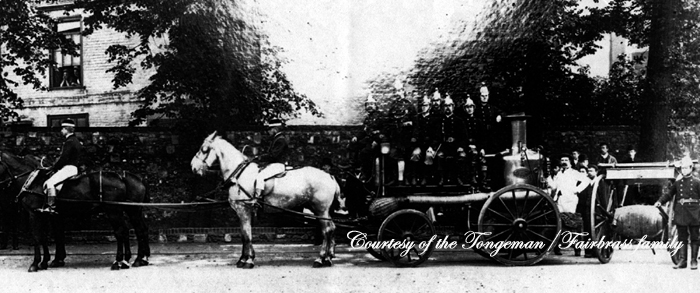
Canterbury Cathedral Fire Brigade. Edward Fairbrass on the far right hand side holding the hose reel.
Credit for this lovely photo goes to the 'Tongeman/ Fairbrass' family.
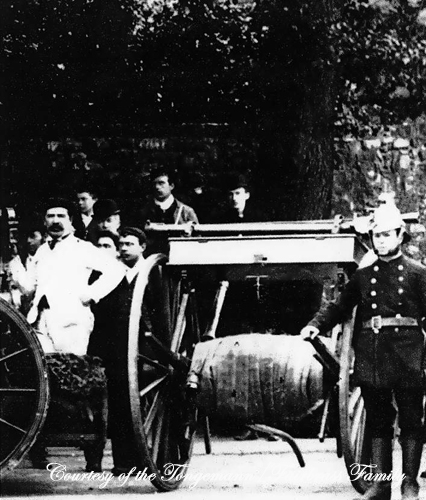
Edward Fairbrass on the far right hand side holding the hose reel. Credit for this lovely photo goes to the 'Tongeman/ Fairbrass' family.
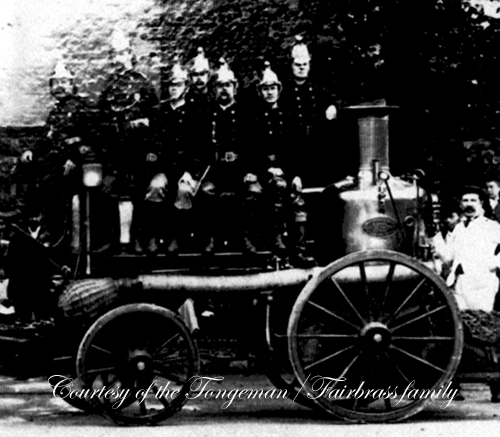
Credit for this lovely photo goes to the 'Tongeman/ Fairbrass' family.
CITY FIRE BRIGADE - 1882
Head quarters; Corn Exchange; consists of one fire escape, four ladders with ropes, 200 feet of hose; J.G. Hall, captain; number of men, 7.
KENT FIRE BRIGAGE - 1882
Head quarters; The Kent Fire office, 29 High Street; consists of one manual fire engine, hose reel & 480 feet of hose; Walter S. Morgan, Supt,; number of men 7.
PHOENIX - 1882
Head quarters; 2 Upper Bridge Street; consists of one manual fire engine, one hose reel & 480 feet of hose; Geo. Wiltshier, supt.; number of men, 7.
----------------------
1889
Samuel H. Horton - City Fireman
John Williams - Labourer & City Fireman
Richard Verrell - Paviour & City Fireman
George Laws - City Fireman
------------------------------
1897
COUNTY FIRE BRIGADE
Capt. W. G. Pidduck
First Lieutenant F. L. Henshaw
Second Lieutenant S. Truscott
*a lovely picture of these men and their engine in "Firefighting in Kent" by Roger C. Mardon, Hughes, John A. Meakins 2005

The Canterbury Fire Brigade in Castle Street, January 1926. The firemen were called to save a cat named Rosie from a tree.
Credit for this lovely photo goes to the 'Tongeman/ Fairbrass' family
CITY FIRE BRIGADE - 1903
Head quarters: Police station, Westgate; four ladders with ropes, 1000 feet of hose; a hose cart & 1 escape: Supt. John W. Farmery, chief of the amalgamated brigades, captain; number of men, 14.
COUNTY (Formed in 1867? 1807?) - 1903
Head quarters, 35 St. George's Street; fire station, Rose lane; Capt. W.G. Pidduck, 2 lieutenants, an engineer & 7 men. The engine is a Merryweather "Paxton" manual, and was, with all the necessary appliances, supplied to the brigade by the directors of the County Fire Office.
KENT FIRE BRIGAGE - 1903
Head quarters, 29 Westgate; Engine house, Palace street, Acting Capt. Leonard T. Ashenden, 2 lieutenants and 6 men; appliances, 1 steam engine, 1 manual, 2 hose reels & 2500 feet of hose.
FIRE ESCAPE - 1903
The city fire escape is kept at the police station and is worked by the police force.
